patterns >  Red Earth Designs
Red Earth Designs
> Helenental Cowl (Crochet)












Helenental Cowl (Crochet)
If you like this pattern, I have more that you’ll love! Sign up for my email newsletter to get special discounts, behind-the-scenes updates, and more!
A field of double crochet becomes the backdrop for columns of eyelets punctuated with puff stitches, reminiscent of long grasses and seed pods waving in an autumn breeze. Worked flat and seamed at the back neck, this bandanna-style cowl works up quickly; the repetition of deceptively simple stitches makes for rhythmic crocheting. Designed to commemorate Ludwig van Beethoven’s 250th birthday, the cowl is named for one of the great composer’s favorite valley haunts, where he frequently took long walks for rest, thought, and inspiration.
Pattern has been tech edited.
Yarn: Malabrigo Rios (worsted; 100% superwash merino wool 210 yd/100 g): Fresco y Seco, 2 hanks
Hooks: One US G/6 (4mm) hook, or size needed to obtain gauge
Notions: Tapestry needle, rigid blocking wires, rustproof pins, blocking mats
Gauge: 15 sts by 8 rows in dc = 4” (10 cm)
Notes: This cowl uses single crochet, double crochet, front post double crochet, back post double crochet, chain spaces, and bobble stitches (see Special Stitches). US terminology is used.
The cowl is worked flat and seamed at the back after blocking (see diagram on Page 4).
The Lace Panel is worked alongside a wedge of double crochets to form the bandanna shape.
Through the Increase Section (see directions below), 1 stitch is increased per row. Through the Straight Section, no stitches are increased.
The sample shown was made with 2 skeins of Malabrigo Rios (420 yd) with very little left over. It may be advisable to have extra yarn. The suggested yarn is categorized as worsted but works up closer to a DK weight; a heavy DK yarn could also be used.
194644 projects
stashed
125039 times
- First published: December 2020
- Page created: December 9, 2020
- Last updated: November 27, 2024 …
- visits in the last 24 hours
- visitors right now






